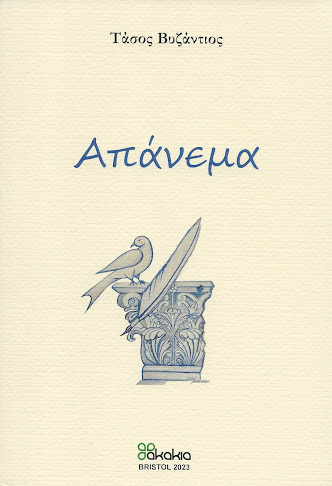Την Τετάρτη 18 Φεβρουαρίου στις 7.00 μ.μ. η Ελληνική
Αρχαιολογική Επιτροπή Μεγ. Βρετανίας οργανώνει στο Ελληνικό Κέντρο (16-18 Paddington Street, London, W1U 5AS) τη χειμερινή της διάλεξη, με θέμα: “Mycenaean Crete:
Religion, State Authority and Royal Symbolism. New Evidence from Crete”.
Ομιλήτρια θα είναι η Δρ Αθανασία Καντά.
Dr Kanta, after
studying history and archaeology at the University of Athens, undertook
postgraduate studies at the Institute of Archaeology, University of London,
where she was awarded her doctoral degree. Her illustrious career included
positions as a lecturer at the University of Wellington, Assistant Professor at
the University of Crete, Director of the Archaeological Institute of
Cretological Studies, Director of the Museum of Heraklion and Director of the 23rd
Ephorate of Prehistoric and Classical Antiquities of Heraklion, Crete, and
since her retirement, Honorary Ephor. She is a Fellow of the Archaeological
Society at Athens, Honorary Professor of Adelphi University of New York and of
the IUSOB, Naples.
Dr Kanta has
published a number of monographs and over 90 articles on Greek Prehistory. Her
most recent books include: the Sacred Cave of Eileithyia in Tsoutsouro
(co-authored with K. Davaras, 2010), Athanasia: the Earthly, the Celestial
and the Underworld from the Late Bronze Age and the Early Iron Age,
(co-authored with N. Stampolidis and A. Giannikouri, 2012) and Minoan
Crete and the origins of Ancient Greek Theatre (2013).
The speaker has
led and participated in more than 100 excavations in Crete, including the
excavations of the palatial complex at Monastiraki of Amari, the Anetaki plot
at Knossos, the Mycenaean Acropolis at Kastrokephala and at the archaeological
sites of Tylissos and Amnisos. In Cyprus she excavated the site at Pyla
Kokkinokremo, in collaboration with Professor Vasos Karagiorgis, which resulted
in a recent publication.
The destruction
of the last palace of Knossos has long been the subject of scholarly
controversy. The destruction date ranges from 1380 to 1200 BC according to the
preference of individual scholars. After this momentous event, the Mycenaeans
became a major force in the SE Mediterranean. A new find at Knossos may shed
light to religious and state matters affecting it at this period.
During the
excavation of a private plot at Knossos, a 2nd century AD temple of
Artemis and Zeus came to light. The location of the plot is significant. It is
adjacent to the so-called sanctuary of Glaukos, on the Knossos hill, to the
west of the contemporary entrance of the Palace and to the south of the Little
Palace. Below this temple there are levels of several periods. Strong evidence
of ritual activity in all levels characterise the site. The total depth of the
fill, belonging to the various periods at the site, is 8.50 metres. Above the
bedrock there is an impressive Minoan Neopalatial building with substantial
walls and evidence of ritual activity.
Above this
building an in situ “fetish shrine”
came to light, its walls partly extending over the Neopalatial building. The
inauguration deposit of a sword, vases left in situ on its floor and LMIIIB
pottery in the fill above its floor, confirm the dates of its construction, use
and abandonment.
The shrine,
which is the subject of this evening’s lecture, may have been abandoned but was
not forgotten by subsequent generations.
This promises to
be a fascinating illustrated presentation by an eminent archaeologist.












































No comments:
Post a Comment